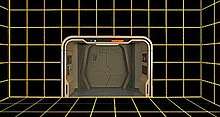Holodeck
| Holodeck | |
|---|---|
 A vacant holodeck on the Enterprise-D; the arch and exit are prominent. |
The holodeck is a fictional plot device from the television series Star Trek. It is presented as a staging environment in which participants may engage with different virtual reality environments. From a storytelling point of view, it permits the introduction of a greater variety of locations and characters that might not otherwise be possible, such as events and persons in the Earth's past, and is often used as a way to pose philosophical questions.
Although the Holodeck has an advantage of being a safer alternative to reality, many Star Trek shows often feature holodeck-gone-bad plot devices in which real-world dangers (like death) become part of what is otherwise a fantasy.
Origins

The holodeck was inspired by inventor Gene Dolgoff, who owned a holography laboratory in New York City[1], and whom Star Trek creator Gene Roddenberry met in 1973.
The first appearance of a holodeck (originally called a 'recreation room') in Star Trek came in the animated series (1974). During the episode "The Practical Joker," Dr McCoy, Sulu and Uhura are trapped inside it by the ship's computer. Within the fictional timeline of the Star Trek universe, the first human encounter with a holodeck comes with an encounter with the alien Xyrillian race in the Star Trek: Enterprise episode "Unexpected".
Science fiction writer Ray Bradbury wrote about a technology-powered "nursery" in his 1950 story "The Veldt." Real-world holograms were invented in the late 20th century, enabled in-part by the development of the laser.
Depiction
The holodeck is depicted as an enclosed room in which objects and people are simulated by a combination of matter, beams and fields onto which holographic images are projected, which appear solid to the touch. This matter is known as "holomatter", and usually disintegrates when the virtual-reality program is ended. However, examples from some episodes show holomatter persisting beyond the confines of the holodeck. In the episode "Encounter at Farpoint", for example, Wesley Crusher falls into a holographic stream, but is shown to be wet even after exiting the holodeck.[2]
Holodeck programs are shown to fall into two broad types. The most commonly depicted type is a program in which the user of the holodeck is shown to be able to interact with the virtual-reality environment and its characters. The lesser-depicted type is a passive mode, in which the user is shown to be an 'unseen' observer in the simulated environment.
Characters in Star Trek are shown to use holodecks for recreation and for work. By simulating settings and events, undertakings in science, logistics and law may be carried out. A wide variety of settings and situations have been portrayed on the holodeck, including a 19th-century American West adventure, and the experiences of Captain Jean-Luc Picard playing the part of one of his boyhood heroes, fictional detective Dixon Hill.
The holodeck is usually shown to be controlled by voice commands, though physical controls have also been shown. There have been several depicted incidents of Star Trek characters being trapped or injured by holodeck malfunctions,[3] leading to later series showing the addition of the safety feature of a hidden computer terminal (the "Arch") which allows access to the holodeck controls.
Holodecks have also been used as a plot device to explore metaphysical questions. In "Elementary, Dear Data", a holodeck character is shown to become self-aware and considers his own identity and existence.[4] In another episode, a holodeck character achieves full sentience and is awarded the same rights as "living" crew members.
Star Trek shows characters known as 'holonovelists', who provide scenarios and stories for use on the holodeck. Some users are shown to develop a pathological addiction to the holodeck, a condition known to the characters as "holo-addiction". Star Trek: Voyager presents alien beings known as "photonic lifeforms" who interact with the ship's crew primarily through holodecks.
One of the opening scenes of the 1994 film Star Trek: Generations features a holodeck scene showing a vessel at sea.[5] In real life the ship Lady Washington was used to create the holodeck scenario.[6]
Reception
The Star Trek: The Next Generation episode "The Big Goodbye" (airdate January 11, 1988), featuring a holodeck story, was, in recognition of its "new standard of quality for first-run syndication" honored with a Peabody Award.[7] "The Big Goodbye" was also nominated for two Emmy Awards in the categories of Outstanding Cinematography for a Series and Outstanding Costumes for a Series, with costume designer William Ware Theiss winning the award in the latter category.[8][9] "The Big Goodbye" is the only Star Trek episode to win a Peabody Award.[10]
Similar technology in other works
- Author Alexander Moszkowski may have been the first person to envisage something resembling a 'holodeck' concept.
- The Nursery in The Veldt (1950) by Ray Bradbury
- In 1965, computer scientist Ivan Sutherland imagined an artificial environment in which mere 'displays' might attain to solid reality.[11]
- Russian science-fiction movie Moscow-Cassiopeia (1973) shows a "Surprise Room" which operates in a similar way to a holodeck.
- Japanese TV series Space Battleship Yamato (1974) features a "resort room" capable of creating simulated environments.
- The X-Men comic book series depicts a training room which was originally depicted as a mechanical affair, but later as using holograms and other sensory simulation.
- Abed Nadir's "dreamatorium" from the third season of the U.S. television sitcom Community is inspired by the holodeck in both its function and its aesthetic.
Notes
- ↑ "Meet The Man Behind The Holodeck, Part 1". StarTrek.com. Retrieved 2016-01-11.
- ↑ Phil Farrand. The Nitpicker's Guide for Next Generation Trekkers New York: Dell (1993)
- ↑ Thomas Richards, The Meaning of Star Trek. New York: Doubleday (1997): 108–109. The Enterprise-D "has two mechanisms aboard that seem especially prone to failure ... the transporter and the holodeck."
- ↑ Richards (1997): 114
- ↑
- ↑
- ↑ "Star Trek: The Next Generation – The Big Good-Bye". Peabody Awards. Retrieved June 15, 2016.
- ↑ "Primetime Emmy Award Database". Emmys.com. Retrieved July 5, 2013.
- ↑ Turner, George (October 1988). "And the Winners are..." American Cinematographer. 69 (10). (subscription required)
- ↑
- ↑ Sutherland, I. (1965). The ultimate display. Proceedings of IFIP Congress 1965, 506–508.
References
- P. Farrand, Nitpicker's Guide for Deep space Nine Trekkers New York: Dell (1996): 44–47
- Lois H. Gresh & Robert Weinberg, Chapter 7, "The Holodeck" The Computers of Star Trek. New York: Basic Books (1999): 127–144
- R. Sternbach & M. Okuda, Star Trek: The Next Generation Technical Manual New York: Bantam Books (1991)
- Gene Dolgoff, "Reproduction of Transmitted, Pre-recorded, Holographic Television Signals in Color" New York: Institute of Electrical and Electronic Engineers (IEEE)(July, 1968)
- Stoppe, Sebastian (2016). "Getting Immersed in Star Trek, Storytelling Between "True" and "False" on the Holodeck" (PDF). SFRA Review (316): 4–15. Retrieved July 20, 2016.